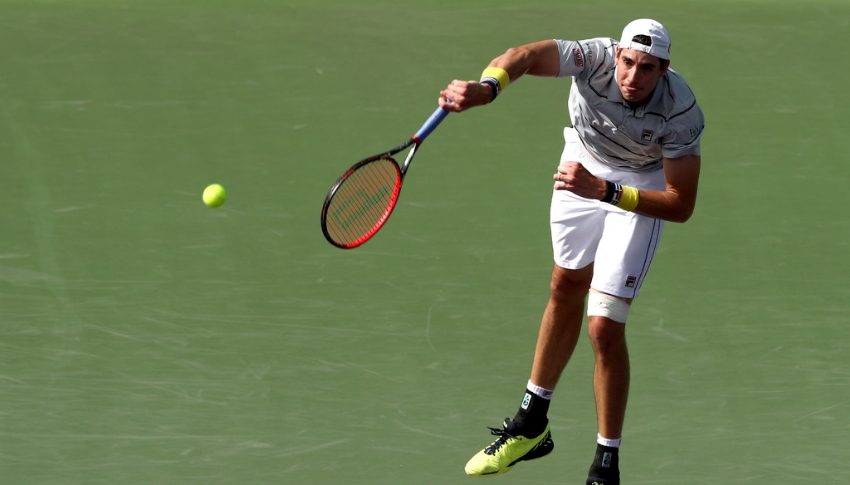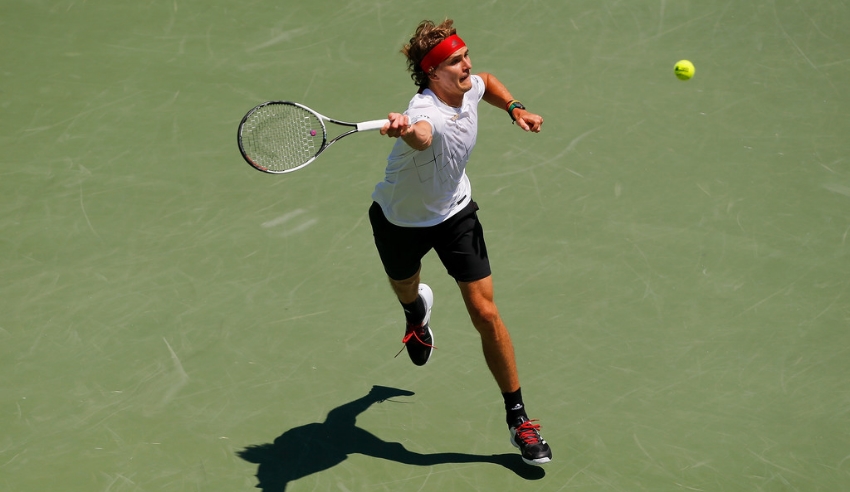Coming into today’s Miami Open final between two in-form players, the fifth-ranked German Alexander “Sascha” Zverev and the 17th-ranked American John Isner, one could not help but wonder what kind of impact each player’s preferred style of play would have on the other.
In the two previous rounds, Zverev won in straight sets against two solid baseliners, Borna Coric and Pablo Carreno-Busta, accelerating efficiently in rallies and overpowering his opponents with accelerations. Isner, for his part, demolished the rising star Hyeon Chung in two routine sets and put a stop to Juan Martin Del Potro’s fifteen-match winning streak. He relied for the most part on his bazooka serves and forehands, and never allowed either of them to settle into their favorite patterns.
This championship match also offered a fascinating background story. On the one hand, Isner had never won an ATP 1000 title but did have a history of performing well on American soil regardless of whether the crowd got behind him or not (see his match from two days ago vs Del Potro). On the other hand, Zverev had never lost in the finals of an ATP 1000, having won both of his previous appearances.
Nevertheless, all that would matter less once the fuzzy ball would get tossed in the air for the first serve of the match. The players’ tennis outputs on the stadium court at Crandon Park would determine the outcome on this day.
Could Isner cook the same recipe that worked so well against Coric and Carreno-Busta, and hinder the German’s well-oiled production of steady, high-paced ground strokes? Could he return big against Sascha, like he did against his previous opponents? In any case, his game plan seemed crystal clear: serve big, return big, nail forehand, and apply pressure.

The answer to how Zverev would respond was a little blurrier. Could Zverev put forth enough power of his own to stop the American from getting the upper hand in the first two shots of each point? Could he stay in the point long enough to exploit Isner’s weaknesses, such as his backhand and footwork? Tennis fans awaited those answers as the players stepped on the court.
The first two sets were decided on a few key points at different times. The third set was, by contrast, the product of an overarching trend that worked against Zverev throughout the match and ultimately doomed him in the late stages of the match.
Unlike what many expected, break chances came early, all in favor of Isner. The way Zverev saved the first two break points (0-1, 15-40) was, on the other hand, very predictable. He hit a wide (and big) first serve to get to 30-40. Then, he engaged Isner in a deliberately paced backhand cross-court rally, the important term being “deliberately” (more on this later). Isner missed his fifth backhand and Sascha got back to deuce.
Isner would get another break-point opportunity two points later, one that he probably regretted for the rest of the set. He set the point up perfectly, approaching the net behind a forehand, but floated a very makeable forehand volley deep. Zverev held with a couple of big first serves.
In the first set, Zverev executed his game plan well. For starters, he stuck with the right pattern in baseline rallies. As noted above, he pinned Isner to the ad corner, making him hit backhands. He knew that Isner would want to run around the backhand and nail forehands, exactly like the American did against Chung and Del Potro. Thus, Zverev was not holding back on his backhand cross-courts, and therefore, not allowing Isner enough time to move outside the court (again, more on this later).
Secondly, Sascha’s first serves were clutch. Whenever he faced a break point, or a 30-30 point, he came up with an ace or an unreturnable serve, shutting the door quickly on Isner. He saved three of the five break points in the first set with big serves and won numerous other free points on important points.
Zverev was also making Isner hit the first volley low. It was not enough for Isner to simply hit his forehand hard and win the point without having to play the next shot. Isner had to showcase his volleying skills to put the ball away. Muscling serves and forehand were not going to be enough. It worked for Zverev. Isner missed some of those volleys, or at least, had to resort to just placing the volley, giving Zverev a second look at a passing shot.
A glaring example of this occurred when Isner got in trouble for the first time on his serve at 2-2. On game point, he hit a big kick serve wide to the ad side (one of his “money” shots) and followed it to the net. Zverev got the backhand return right down to Isner’s feet. Although Zverev was way outside the court when he returned, he was able to recover and chase the next ball down because Isner had to hit the low volley upward. Zverev ran it down and passed Isner cross-court with his forehand. Although Isner ended up holding serve, he knew he had to stay on his toes, even behind good serves and approaches. That is the type of pressure that, if applied consistently, works on you and makes a difference on an important point later in the match.
It did, in the tiebreaker…
The quality of tennis significantly dropped in the tiebreaker, for one reason or another. Both players committed uncharacteristic errors and lost awkward points on patterns that should have otherwise favored them. Until Zverev led 3-2, nothing looked out of the ordinary. The German won his two serving points on big first serves and he earned the mini break on yet another low volley that he forced Isner to hit. That was the pay-off (see above) for Zverev repeatedly making Isner hit low first volleys.
Zverev lost his mini-break advantage though, and more, when he committed two unforced backhand errors in a row to go down 4-3. Then Isner missed a forehand and double-faulted to return the favor. Remember, I did use the adjectives “awkward” and “uncharacteristic” earlier to describe what happened in this tiebreaker, so you were warned.
The last two points showcased again the winning formula(s) that Zverev adopted throughout the set. Another clutch first serve put him up 6-4. On set point, Zverev once again engaged Isner in a rally, making the American hit several backhands until he missed.
So, what went wrong for Zverev – or right for Isner – after the first set? Not much actually, except in two specific games, one in each set, and the overarching trend on which I touched at the beginning and kept putting off by saying “more on this later.” That is all it took for the American to grab the biggest title of career.
Until 4-4 in the second set, players held serves without difficulty. Then suddenly, on his serve, Zverev played by far the worst game of the match thus far. Out of nowhere, leading 30-15, Zverev squeezed in two unforced errors (one of them, a forehand framed to the sky) and a double fault to give Isner his first break-point opportunity of the set, the only one he needed.
And this is where I finally get to the overarching trend that doomed Sascha.
On that break point, Sascha had a mid-court backhand, similar to the ones he had all along the first set and a half, one that he has been taking early at shoulder level and drilling cross-court. That pattern, until then, regularly pushed Isner to the backhand corner and allowed Zverev to settle into the favorable cross-court-backhand pattern. Instead, and inexplicably, Zverev held back and hit a mid-pace backhand on which Isner was able to run around his backhand and pound a forehand. Zverev responded with another defensive, and shorter, backhand. This time Isner stepped inside the court and unleashed his forehand for a winner, grabbing the first break of the match.
Isner won the second set on his serve in the next game, although he had to save a couple of break points. More importantly for him, the trend from Sascha freely hitting his backhands cross-court and out-rallying him to Sascha hitting his backhands tentatively and giving him a shot at running around to unload his forehands was now in full progress.
Zverev’s success with his first serves still continued. He saved break points early in the third set with big serves. Plus, he was still making Isner hit low volleys when the American ventured to the net. Those two factors remained in his favor. However, extended rallies were no longer a write-in for Zverev like they were in the first 90 minutes of the match.
And you could tell that Isner was smelling blood because, you see, when a player shows apprehensiveness, it is not just the previously working pattern that loses traction for him. His loss of confidence, and Zverev’s body language tends to show this, motivates the opponent to gain mental momentum. Hence, Isner began staying in rallies longer because he now believed that Zverev, due to his tentative baseline play, would eventually hold back on one shot somewhere and give him a chance to take charge in the rally.

At 4-4 in the final set, Zverev’s increasing malaise on his ground strokes had spread to the rest of his game. Even his reliable first serve disappeared. He began with a double fault. Then, Isner, full of confidence, hit a thunder return on a first serve, and followed it with a forehand winner to go up 0-30. One point later, at 15-30, he had to serve a second serve and get in a rally. If there were a rally to show how much Zverev had regressed – the overarching trend – in the deliberate nature of his ground strokes, this would be the one.
He had a sitter on his backhand inside the baseline, in the middle of the court, on a ball by Isner that bounced inside the service line. Instead of accelerating to the backhand corner of Isner, like he has done numerous times throughout the first set and a half (and the tournament), Zverev simply half-looped the backhand back to the middle of the court heck, (he might have even slightly mishit it). Isner moved up and hit a forehand back to Sascha’s backhand. It was deeper but nothing that Sascha could not handle. The German missed the routine backhand deep by over a meter at least.
The miss, and his body language after the miss, pointed to one thing: he had lost his mental edge. The ensuing break point confirmed it. Another rally, another set of baseline shots underplayed by Zverev, ending with an easy forehand sitter slammed in the net. He smashed his racket to the ground, twice, and broke it. It seemed that the match had ended there.
Isner served up the formalities, literally, with three aces to earn his first ATP 1000 title.
The match was more of a mental battle than anything else. The quality of tennis was higher in the first half of the encounter, minus the tiebreaker. The tactical adjustments made by both players, on the other hand, were remarkable. The battle of IQs had no clear winner, both players proved potent there, but the one with the higher resolve stood tall, no pun intended, at the end.
